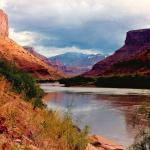
We’re surrounded in this remote area of southeastern Utah by magnificent vistas and fascinating geology. And yet, one of the great things here, with the three other couples who have come here with us, as well as elsewhere is time spent simply talking, sharing stories, reflecting on our deepest believes. I always think, in such settings, of the familiar song from the late John Denver:
I have to say it now, it’s been a good life all in allIt’s really fine to have the chance to hang aroundAnd lie there by the fire and watch the evening tireWhile all my friends and my old ladySit and pass the pipe aroundAnd talk of poems and prayers and promisesAnd things that we believe inHow sweet it is to love someoneHow right it is to careHow long it’s been since yesterdayWhat about tomorrow?What about our dreamsAnd all the memories we share?
Sweet is the work, my God, my KingTo praise thy name, give thanks and sing,To show thy love by morning light,And talk of all thy truths at night.

Last week, I recorded an interview with Casey Griffiths and Scott Woodward for Scripture Central’s Church History Matters podcast. It’s now up and available online:
“What If All the Apostles Died At Once? Succession Q&R with Dr. Daniel C. Peterson”
In the unlikely event that the First Presidency and Quorum of the Twelve all died simultaneously, how would that affect succession? In this hypothetical worst-case scenario, would the keys of the kingdom be lost? And, if an apostle came down with a debilitating health problem, is there any precedent for making him an emeritus apostle?
And speaking of apostles, is there a set procedure in calling them, or does the method vary from Church president to president? Also, sometimes in the Church people speak of a special requirement for a man to become an apostle—the phrase “sure” or “special” witness of Christ comes up a lot. What’s true? Must a man have personally seen Jesus Christ in order to be fully considered an apostle?
On this episode of Church History Matters Casey and I are joined by a special guest, Dr. Daniel C. Peterson, to help us answer these and other great questions related to succession.
For show notes and transcript for this and other episodes go to https://doctrineandcovenantscentral.org/church-history-matters-podcast/

I’m sorry that I failed to remind you in a timely fashion of tonight’s installment in the Interpreter Foundation’s Mesoamerica Lecture Series. I just finished watching it, and it was excellent. If you’re interested in viewing the lecture, though, don’t despair: It was recorded, and a video of it will be posted on the Interpreter website in the near future. Here is the description of the lecture that was posted:
Our tour host, Brant Gardner, will present a lecture entitled “Mesoamerica and the Book of Mormon Side by Side.” One of the reasons that many suggest that there is no archaeological evidence for the Book of Mormon is that they are looking for the wrong things in the wrong places. Rather than looking at the archaeology to see what Old World culture might be there, we should look at the Book of Mormon as a text created in a particular time and place, and find within the text where it reflects the times and places of its origin. As we place the Book of Mormon side by side with what we know of Mesoamerican history, we can see how incidents in the text have been developed within the context of a Mesoamerican culture. That cultural context explains why Nephi’s people desired a king so early in Nephite history, and why the Nephite society ended at the time it did–and not before or after. In between, multiple correspondences with culture, time, and space support the idea that the Book of Mormon was written by authors who lived in a very specific, and reasonably known, culture and time.
Brant A. Gardner (M.A. State University of New York Albany) is the author of Second Witness: Analytical and Contextual Commentary on the Book of Mormon, The Gift and Power: Translating the Book of Mormon, and Traditions of the Fathers: The Book of Mormon as History, each published through Greg Kofford Books. Both The Gift and Power and Traditions of the Fathers were awarded best in category by the Association for Mormon Literature. He has contributed articles to Estudios de Cultura Nahuatl and Symbol and Meaning Beyond the Closed Community, published by the State University of Albany. He has published several articles on the Book of Mormon in Interpreter: A Journal of Mormon Scripture. He has also presented several papers focused on the Book of Mormon at FAIR conferences.
The remaining schedule for the Interpreter Foundation’s Mesoamerican Lecture Series is as follows:
18 September: Allen Christenson, “Palenque World Tree.” (This lecture will not be recorded for future viewing. It can only be watched live.)
25 September: Benjamin Jordan, “Potential Volcanic Activity Related to Events in the Book of Mormon.”
And, by the way, a few spots on this Mesoamerica tour came unexpectedly open several days ago. I don’t know whether the vacancies still exist but, if you’re interested, it might be worth a phone call.
Posted from Moab, Utah













